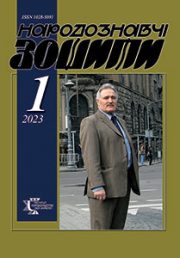The Ethnology Notebooks. 2024. № 2 (176), 450—455
UDK 908-051(477)Г.Дем’ян:725.94″1963″(477.83-22Славсько)
DOI https://doi.org/10.15407/nz2024.02.450
HRYHORII DEMIAN — THE INITIATOR OF TARAS SHEVCHENKO’S MONUMENT INSTALLATION IN SLAVSKO
SOKIL Hanna
- ORCID ID: https://orcid.org/0000-0002-8352-2124
- Doctor of Philological Sciences, Professor,
- Ivan Franko National University of Lviv,
- department of Ukrainian folkloristics,
- 1,Universytetska Street, 79000, Lviv, Ukraine,
- Contacts: e-mail: gan.sokil@gmail.com
Abstract. The article considers one of the vectors of Hryhorii Demian’s local history and educational work, which, alongside pedagogical and scientific pursuits, was a priority in his social activities. Young local historians led by him were wandering around Shevchenko’s places and taking part in trips along Franko’s paths,
Lesya Ukrainka’s trails. After founding a local history club in Slavsko secondary school, Hryhorii intensified activities on the ground, organizing students to record ethnographic and folklore materials, and got them acquainted with the works of famous literature and art figures. On Shevchenko Days, he suggested local authorities build a bust of the Kobzar in the mountain village Slavsko. At his initiative, the monument was installed in November 1963. This event is of great importance as it fosters civic position and a sense of patriotism in young people. The relevance of the article is in the fact that it is dedicated to Hryhorii Demian’s 95th birthday anniversary, who directly contributed to the installation of a monument to the Ukrainian poet and artist Taras Shevchenko in Slavsko 60 years ago.
The aim of the article is to reveal the history of the monument’s creation and highlight the role of Hryhorii Demian’s active civil position in this process. It covers the initiative of construction idea, the choice of location, the production and installation of the monument, as well as the obstacles and prohibitions from the party authorities, the perception and reverence of the Kobzar by the residents.
The article’s source materials include separate publications in the press about local history trips to Shevchenko’s places led by H. Demian, as well as his unpublished article «On the History of the Monument to T.H. Shevchenko in Slavsko» written in April 1964, which is kept in the manuscripts department of the V. Stefanyk National Scientific Library of the National Academy of Sciences of Ukraine in Lviv.
Keywords: civil position, local history work, monument, Shevchenko’s places.
Received 15.02.2024
REFERENCES
- Skuratіvskyi, V. (1985, october 1). The Guardianof Pearls (Forthe «Our Contemporary» contest). Soviet Education (P. 3) [in Ukrainian].
- Demyan, H. (1963, march 30). Through Shevchenko’s Places. Builder of Communism. Stryi [in Ukrainian].
- Demyan, H. (1964). To the History of the T.H. Shevchenko Monument in Slavske. Article. Manuscript. V. Stefanyk National Science Library of the National Academy of Sciences of Ukraine. Fund 207. Collectionunit 14. Lviv [in Ukrainian].






